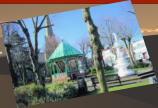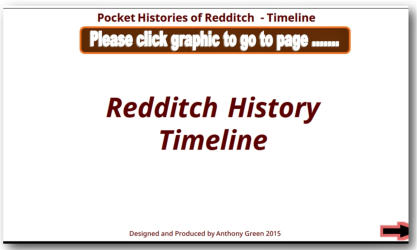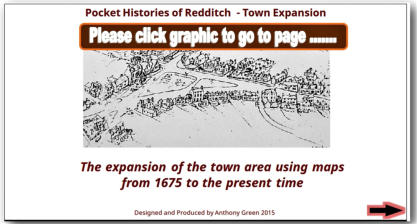

After the dissolution of Bordesley Abbey in 1538 the town of Redditch began to grow and the Gatehouse chapel at Bordesley was restored for Redditch people.
Redditch then meant a number of houses and small cottages grouped round the cross roads at what is now Church Green and the population continued to grow
as the needle industry prospered.
It was soon found necessary to bring the chapel nearer to them and a chapel was built on the green, on the site now occupied by the Parish Church.
Redditch then began to take the shape we now know. Schools and churches were built and the town soon became a parish, and was no longer a part of
Tardebigge Parish. This was in 1846, and was followed after a few years by the building of the Parish Church. A few more years and the railway had come to
Redditch, while its roads to other towns were improved, and a new road made to Birmingham. It was a century of great activity and the boundaries began to
expand .
This continued into the 20th Century as more industries came into the town, and the making of needles and fishing tackle was joined by motorbikes, springs,
batteries and other light industry.The most recent major change for Redditch was the designation as a new town in 1964 and, since that time, the population has
increased from 32,000 to nearly 80,000 and has been transformed in many ways.

Designed and Maintained by Anthony Green
INTRODUCTION
Redditch History






There are two introductory ‘pocket histories’ of Redditch. Please click on the image to go to the relevant page.
Redditch History is part of my Explore Redditch group of websites


After the dissolution of Bordesley Abbey in 1538 the town of
Redditch began to grow and the Gatehouse chapel at Bordesley
was restored for Redditch people. Redditch then meant a number
of houses and small cottages grouped round the cross roads at
what is now Church Green and the population continued to grow
as the needle industry prospered.
It was soon found necessary to bring the chapel nearer to them
and a chapel was built on the green, on the site now occupied by
the Parish Church.
Redditch then began to take the shape we now know. Schools and
churches were built and the town soon became a parish, and was
no longer a part of Tardebigge Parish. This was in 1846, and was
followed after a few years by the building of the Parish Church. A
few more years and the railway had come to Redditch, while its
roads to other towns were improved, and a new road made to
Birmingham. It was a century of great activity and the boundaries
began to expand .
This continued into the 20th Century as more industries came
into the town, and the making of needles and fishing tackle was
joined by motorbikes, springs, batteries and other light
industry.The most recent major change for Redditch was the
designation as a new town in 1964 and, since that time, the
population has increased from 32,000 to nearly 80,000 and has
been transformed in many ways.

Designed and maintaned by Anthony Green
INTRODUCTION
Redditch History




















